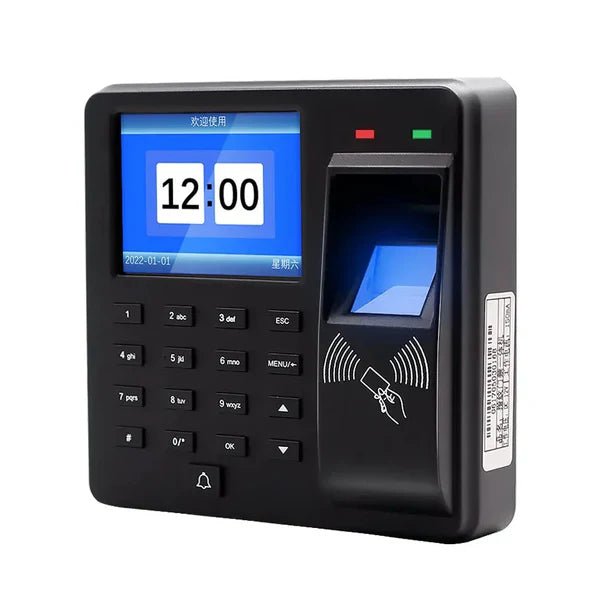
The Modern Timekeeper: Why Every Business Needs a Biometric Fingerprint Time Attendance Clock
Share
Introduction
In a world driven by accuracy, accountability, and automation, businesses are no longer relying on outdated punch cards or spreadsheets to manage attendance. Instead, they are embracing smarter technologies—one of the most effective being the Biometric Fingerprint Time Attendance Clock.
This compact, intelligent device has become a staple in modern workplaces. From factories and offices to schools and retail stores, it’s revolutionizing the way organizations track employee hours and access.
But what makes this little machine so powerful? And why should your business invest in one?
Let’s dive in.
What Is a Biometric Fingerprint Time Attendance Clock?
At its core, this device is a digital time-tracking system that uses fingerprints to verify an individual’s identity. Unlike traditional swipe cards or pin-based systems, it relies on unique biometric data, making it virtually impossible to fake.
It typically includes:
- A fingerprint scanner
- A keypad
- A digital clock display
- An RFID/NFC card reader
- Built-in storage to store data or sync with the cloud
Some models even offer WiFi or LAN connectivity to integrate with payroll systems.
The Problem with Traditional Attendance Systems
Many businesses still use outdated timekeeping systems like:
- Manual sign-in sheets
- Magnetic swipe cards
- PIN codes or passwords
These systems are inherently flawed:
- Buddy punching (when a colleague clocks in for another)
- Lost or stolen cards
- Inaccurate records
- Manual errors in payroll
These issues not only cost businesses money but also erode trust within teams.
Top Benefits of the Biometric Fingerprint Time Attendance Clock
1. Accurate & Tamper-Proof
No two fingerprints are the same. That means each clock-in or clock-out is 100% unique, leaving no room for manipulation or time theft.
2. Boosts Employee Accountability
When employees know their attendance is tracked biometrically, punctuality becomes a habit rather than an obligation.
3. Streamlines Payroll
Integrating the device with payroll software automates calculations—eliminating human errors and saving hours of administrative work.
4. Improves Security
Many models double as door access control systems, granting entry only to authorized personnel.
5. Saves Time
Gone are the days of long queues at the sign-in desk. A simple tap or scan gets the job done in seconds.
How to Set It Up in Your Office
Setting up the system is easier than you think:
- Mount the device near the entrance or designated checkpoint.
- Register employee fingerprints in the database.
- Connect the device to a power source and optionally to a computer or server.
- Sync with your attendance management software.
- Start tracking!
It’s a plug-and-play solution that even small businesses can implement within a day.
Real-World Use Case: A Retail Store's Transformation
Take, for example, a medium-sized retail store in downtown Manila. The owner was struggling with staff frequently arriving late and buddy punching.
After installing the biometric time clock:
- Tardiness dropped by 70% in just one month.
- Payroll errors became a thing of the past.
- Staff morale improved due to fairer systems.
Things to Consider Before Buying
Before choosing a biometric attendance clock, look for:
- Fingerprint recognition speed (ideally <1 second)
- Capacity (how many users it can store)
- Integration with payroll systems
- Power backup or battery options
- RFID or NFC support
- Ease of use/interface
Final Thoughts
The Biometric Fingerprint Time Attendance Clock isn’t just a gadget—it’s a game-changer for managing time and people effectively. It’s your silent manager that never takes a break and ensures that every second counts.
If you're looking to improve discipline, streamline processes, and create a more transparent work culture—this is the tool to invest in.
FAQs
Q1: Is biometric data stored securely?
Yes. Most devices encrypt fingerprint data, and only store a mathematical representation—not the actual image.
Q2: Can it be used outdoors?
Some models are weatherproof. For others, it’s best to install them indoors or in sheltered areas.
Q3: What happens during a power outage?
Many models come with a battery backup or can store offline data until the power resumes.
Q4: Is it difficult to install?
Not at all. Most come with wall-mount kits and user-friendly instructions. Tech support is usually available too.
Q5: Can employees still use RFID cards instead of fingerprints?
Yes, dual-authentication is common. You can use fingerprints, RFID cards, or both.
